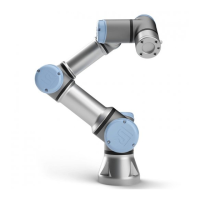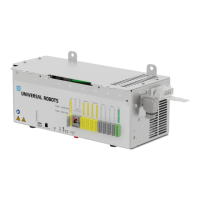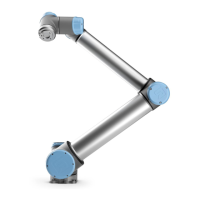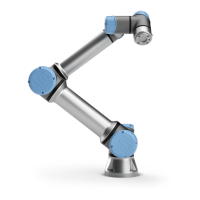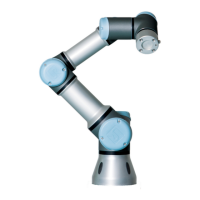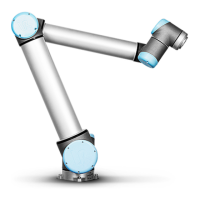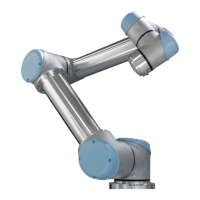10.12 Boundaries
Maximum Speed This option defines the maximum angular velocity for each
joint. This is done by tapping the corresponding text field and entering the new
value. The highest accepted value is listed in the column titled Maximum. None of
the values can be set below the tolerance value.
Note that the fields for limits in Reduced mode are disabled when neither a safety
plane nor a configurable input is set to trigger it (see 10.12 and 10.13 for more de-
tails). Furthermore, the limits for Reduced mode must not be higher than their Nor-
mal mode counterparts.
The tolerance and unit for each limit are listed at the end of the row that corre-
sponds to it. When a program is running, the speed of the robot arm is automat-
ically adjusted in order to not exceed any of the entered values minus the toler-
ance (see 10.4). Note that the minus sign displayed with each tolerance value is
only there to indicate that the tolerance is subtracted from the actual entered value.
Nevertheless, should the angular velocity of some joint exceed the entered value
(without tolerance), the safety system performs a Stop Category 0.
Position Range This screen defines the position range for each joint. This is done
by tapping the corresponding text fields and entering new values for the lower and
upper joint position boundary. The entered interval must fall within the values
listed in the column titled Range and the lower boundary cannot exceed the upper
boundary.
Note that the fields for limits in Reduced mode are disabled when neither a safety
plane nor a configurable input is set to trigger it (see 10.12 and 10.13 for more de-
tails).
The tolerances and unit for each limit are listed at the end of the row that cor-
responds to it. The first tolerance value applies to the minimum value and the
second applies to the maximum value. Program execution is aborted when the po-
sition of a joint is about to exceed the range resulting from adding the first tolerance
to the entered minimum value and subtracting the second tolerance from the en-
tered maximum value, if it continues moving along the predicted trajectory. Note
that the minus sign displayed with the tolerance value is only there to indicate that
the tolerance is subtracted from the actual entered value. Nevertheless, should the
joint position exceed the entered range, the safety system performs a Stop Category
0.
10.12 Boundaries
In this tab you can configure boundary limits consisting of safety planes and a limit
on the maximum allowed deviation of the robot tool orientation. It is also possible
to define planes that trigger a transition into Reduced mode.
Safety planes can be used to restrict the allowed workspace of the robot by enforc-
ing that the robot TCP stay on the correct side of the defined planes and not pass
through them. Up to eight safety planes can be configured. The constraint on the
orientation of tool can be utilized to ensure that the robot tool orientation does not
deviate more than a certain specified amount from a desired orientation.
CB3 II-12 Version 3.4.5
Copyright © 2009–2017 by Universal Robots A/S. All rights reserved.

